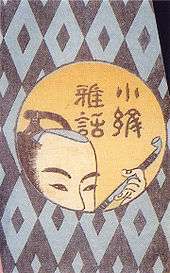Santō Kyōden


Santō Kyōden (山東 京伝, September 13, 1761 Edo – October 27, 1816) was a Japanese poet, writer and artist in the Edo period. His real name was Iwase Samuru (岩瀬 醒), and he was also known popularly as Kyōya Denzō (京屋伝蔵 kyōya denzō). He is the brother of Santō Kyōzan.
Life
Santō Kyōden was born in Fukagawa in Edo (modern Tokyo). The Iwase family into which he was born were pawnbrokers in a lumberyard. He studied ukiyo-e under master Kitao Shigemasa (北尾 重政), and began illustrating kibyōshi under the pseudonym of Kitao Masanobu (北尾 政寅). He soon started writing these novels also under the name of Santō Kyōden; several novels are labeled as written by Santō Kyōden and illustrated by Kitao Masanobu. He wrote kibyōshi and sharebon in great numbers, and became a popular writer. During this time he married twice, both his wives being licensed workers of Yoshiwara, the red-light district of Edo.
During the Kansei Reforms, "[...] military and civil arts were encouraged, and the decadent writings of gesaku authors were condemned." In 1791, Kyōden published three sharebon: Shikake Bunko (仕懸文庫), Nishiki no Ura (錦之裏), and Shōgi Kinuburui (娼妓絹籭). This incurred the anger of the stricter government and he was chained in manacles to his house for fifty days as punishment.[1][2]
Kyōden then broke off all ties with sharebon and turned to writing yomihon. Kyokutei Bakin joined with Kyōden to write gesaku jointly, and independently Kyōden also wrote essentially historical texts on the manners and customs of the Edo period. Kyōden was an acute observer of life in the Edo period. While at ease with exaggeration, comedy and linguistic fun, his writing was primarily realistic.
Fiction writers prior to Kyōden generally wrote fiction as a hobby without any expectations of payment. Kyōden was one of the pioneers in turning this hobby into a livable profession.
Major works
Kibyōshi
- Those Familiar Bestsellers (御存商売物 Gozonji no Shōbaimono) (1782)
- Playboy, Roasted à la Edo (江戸生艶気蒲焼 Edo umare uwaki no kabayaki) (1785)
- The Unseamly Silverpiped Swingers (扮接銀煙管 Sogitsugi gingiseru) (1788)
- Shingaku Hayasomekusa (心学早染草) (1790)
Sharebon
- Musukobeya (令子洞房) (1785)
- The Palace (通言総籬 Tsūgen Sōmagaki) (1787)
- Kokei no Sanshō (古契三娼) (1787)
- The Forty-Eight Grips in Buying a Whore (傾城買四十八手 Keiseikai Shijūhatte) (1790)
- Shigeshige Chiwa (繁千話) (1790)
- Shikake Bunko (仕懸文庫) (1791)
- Nishiki no Ura (錦之裏) (1791)
- The Courtesan's Silken Sieve (娼妓絹籭 Shōgi Kinuburui) (1791)
Yomihon
- Chūshin Suikoden (忠臣水滸伝) (1799)
- Udonge Monogatari (優曇華物語) (1804)
- Sakura Hime Zenden Akebono no Zōshi (桜姫全伝曙草子) (1805)
- Mukashigatari Inazuma Byōshi (昔話稲妻表紙) (1806, translated by Carmen Blacker as "The Straw Sandal Or The Scroll of the Hundred Crabs", Global Oriental, 2008, ISBN 1-905246-64-1)
Historical works
- Kinsei Kiseki-kō (近世奇跡考) (1804)
- Curios (骨董集 kottō-shū) (1813)
See also
Notes
References
- Keene, Donald (1976). World Within Walls: Japanese Literature of the Pre-Modern Era 1600-1867. New York: Grove Press. ISBN 0-394-17074-1.
- Adam L. Kern (2006). Manga from the Floating World: Comicbook Culture and the Kibyôshi of Edo Japan. Harvard University Asia Center. ISBN 0-674-02266-1.
- Kubota, Jun (2007). Iwanami Nihon Koten Bungaku Jiten (in Japanese). Iwanami Shoten. ISBN 978-4-00-080310-6.
- Earl Miner, Hiroko Odagiri and Robert E. Morrell (1985). The Princeton Companion to Classical Japanese Literature. Princeton University Press. pp. 224&ndash, 225. ISBN 0-691-06599-3.
- This article incorporates material from the equivalent article in the Japanese Wikipedia.
External links
- "「浮世絵類考」と写楽について (Japanese)". On Ukiyoe Kinds and Sharaku. Retrieved 2006-07-09.
- (in Japanese) 佐藤 藍子. 京伝の読本文体. 東京大学国文学論集 (3), 115-127, 2008-05. Profile page at University of Tokyo. Profile page at CiNii